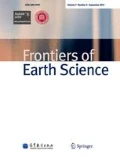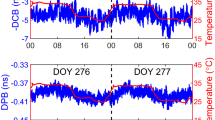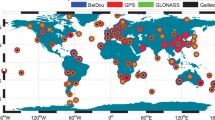Abstract
The multi-antenna synchronized global navigation satellite system receiver is a high precision, low cost, and widely used emerging receiver. Using this type of receiver, the satellite and receiver clock errors can be eliminated simultaneously by forming between antenna single-differences, which is equivalent to the conventional double-difference model. However, current multi-antenna synchronized global navigation satellite system receiver products have not fully realized their potential to achieve better accuracy, efficiency, and broader applications. This paper introduces the conceptual design and derivable products of multi-antenna synchronized global navigation satellite system receivers involving the aspects of attitude determination, multipath effect mitigation, phase center variation correction, and ground-based carrier phase windup calibration. Through case studies, the advantages of multi-antenna synchronized global navigation satellite system receivers in high-precision positioning applications are demonstrated.
Similar content being viewed by others
References
Alber C, Ware R, Rocken C, Braun J (2000). Obtaining single path phase delays from GPS double differences. Geophys Res Lett, 27(17): 2661–2664
Ashtech Inc. (1991). 3DF 24-Channel GPS measurement system. Houston: Ashtech Inc.
Banville S, Tang H (2010). Antenna rotation and its effects on kinematic Precise point positioning. In: Proceedings of ION GNSS-2010. Portland, OR, 2545–2552
Bilich A (2006). Improving the Precision and Accuracy of Geodetic GPS: Applications to Multipath and Seismology. Dissertation for Ph. D degree. Boulder: University of Colorado
Bilich A, Mader G L (2010). GNSS absolute antenna calibration at the National Geodetic Survey. In: Proceedings of ION GNSS-2010. Portland, OR, 1369–1377
Bock Y, Nikolaidis R, de Jonge P J, Bevis M (2000). Instantaneous geodetic positioning at medium distances with the Global Positioning System. J Geophys Res, 105(B12): 28223–28254
Cannon M E, Berry E, King M (1993). Testing a lightweight GPS/GIS terminal for sub-meter DGPS positioning. In: Proceedings of ION GPS-93. Salt Lake City, UT, 1011–1020
Cannon M E, Lachapelle G (1992). Analysis of a high-performance C/A code GPS receiver in kinematic mode. Navigation, 39(3): 285–300
Choi K, Bilich A, Larson K M, Axelrad P (2004). Modified sidereal filtering: implications for high-rate GPS positioning. Geophys Res Lett, 31(22): L22608
Cohen C E (1992). Attitude Determination Using GPS. Dissertation for Ph.D drgree. Stanford: Stanford University
Cohen C E, Parkinson B W (1991). Mitigating Multipath in GPS-Based Attitude Determination. In: 14th AAS Guidance and Control Conference. Keystone, Colo, 53–68
Dong D N, Chen W, Cai MM, Zhou F, Xia J C, ChengMF, Yu C, Qiu S (2015a). Attitude determination solution for multi-antenna synchronized GNSS receiver. 201510015460.6.
Dong D N, Chen W, Yu C, Cai M M, Zhou F, Cheng Y N, Cheng M F, Lv J Y, Qiu S (2015b). Azimuth angle determination method from estimated ground-based carrier phase wind-up with multi-antenna synchronized GNSS receiver. 201510096274.X.
Dong D N, Zheng Z Q, Kuang L, Chen W, Wang Y F, Zeng Z, Song L, Zhou F, Cai M M, Zhang Q Q, Xia J C (2014). Multipath hemispherical model (MHM) for multipath mitigation. 201410310467.6.
Fenton P C, Falkenberg B, Ford T, Ng K, Van Dierendonck A J (1991). NoVatel’s GPS receiver-the high performance OEM sensor of the future. In: Proceedings of ION GPS-91. Albuquerque, NM, 49–58
Fuhrmann T, Luo X G, KnöpflerA, Mayer M (2015). Generating statistically robust multipath stacking maps using congruent cells. GPS Solut, 19(1): 83–92
Ge L L, Han S W, Rizos C (2000). Multipath mitigation of continuous GPS measurements using an adaptive filter. GPS Solut, 4(2): 19–30
Ge M, Gendt G, Rothacher M, Shi C, Liu J (2008). Resolution of GPS carrier-phase ambiguities in Precise Point Positioning (PPP) with daily observations. J Geod, 82(7): 389–399
Genrich J, Bock Y (1992). Rapid resolution of crustal motion at short ranges with the Global Positioning System. J Geophys Res, 97(B3): 3261–3269
Hermann B R (1985). A Simulation of the navigation and orientation potential of the Ti-Agr. Mar Geod, 9(2): 133–143
Keong J, Lachapelle G (2000). Heading and pitch determination using GPS/GLONASS. GPS Solut, 3(3): 26–36
Kouba J, Héroux P (2001). Precise point positioning using IGS orbit and clock products. GPS Solut, 5(2): 12–28
Kruczynski L R, Li P C, Evans A G, Hermann B R (1989). Using GPS to determine vehicle attitude: USS Yorktown test results. In: Proceedings of ION GPS-89. Colorado Springs, 163–171
Larson K M, Bilich A, Axelrad P (2007). Improving the precision of high-rate GPS. J Geophys Res, 112(B5): B05422
Li Y, Zhang K, Roberts C, Murata M (2004). On-the-fly GPS-based attitude determination using single- and double-differenced carrier phase measurements. GPS Solut, 8(2): 93–102
Lu G, Lachapelle G, CannonME, Vogel B (1994). Performance analysis of a shipborne gyrocompass with a multi-antenna GPS system. In: Proceedings of IEEE PLANSc94. Las Vegas, 337–343
Mader G (1999). GPS antenna calibration at the national geodetic survey. GPS Solut, 3(1): 50–58
Nee R D J V (1992). The multipath estimating delay lock loop. In: Proceedings of IEEE 2nd Symposium on Spread Spectrum Techniques and Applications. Yokohama, 39–42
Ragheb A E, Clarke P J, Edwards S J (2007). GPS sidereal filtering: coordinate and carrier-phase-level strategies. J Geod, 81(5): 325–335
Rothacher M, Schaer S, Mervart L, Beutler G (1995). Determination of antenna phase center variations using GPS data. In: Proceedings of the IGS Workshop. Potsdam, Germany
Schupler B R, Clark T A, Allshouse R L (1995). Characterizations of GPS user antennas: reanalysis and new results. In: Beutler G et al., eds. GPS Trends in Precise Terrestrial, Airborne, and Spaceborne Applications. IAG Symposia, Vol.115. Boulder, CO, USA: Springer Verlag
Souza E M, Monico J F G (2004). Wavelet shrinkage: high frequency multipath reduction from GPS relative positioning. GPS Solut, 8(3): 152–159
Tetewsky A K, Mullen F E (1997). Carrier phase wrap-up induced by rotating GPS antennas. GPS World, 8(2): 51–57
Teunissen P J G (1995). The least-squares ambiguity decorrelation adjustment: a method for fast GPS integer ambiguity estimation. J Geod, 70(1-2): 65–82
Teunissen P J G, de Jonge P J, Tiberius C C J M (1997). The leastsquares ambiguity decorrelation adjustment: its performance on short GPS baselines and short observation spans. J Geod, 71(10): 589–602
Townsend B, Fenton P (1994). A practical approach to the reduction of pseudorange multipath errors in A L1 GPS receiver. In: Proceedings of ION GPS-94, Salt Lake City, 143–148
UNAVCO (1995). Receiver and Antenna Test Report. University Navstar Consortium (UNAVCO) Academic Research Infrastructure (ARI), Boulder, Colorado
Van Dierendonck A J, Fenton P, Ford T (1992). Theory and performance of narrow correlator spacing in a GPS receiver. Navigation, 39(3): 265–283
Wilson G J, Tonnemacher J D (1992). A GPS attitude determination system. J Navig, 45(2): 192–204
Wu J, Wu S, Hajj G, Bertiger W, Lichten S (1993). Effects of antenna orientation on GPS carrier phase. Manuscr Geod, 18(2): 91–98
Wübbena G, Menge F, Schmitz M, Seeber G, Völksen C (1996). A new approach for field calibration of absolute antenna phase center variations. In: Proceedings of ION GPS-96. Kansas City, MO, 1205–1214
Ye S R, Chen D Z, Liu Y Y, Jiang P, TangW M, Xia P F (2014). Carrier phase multipath mitigation for BeiDou navigation satellite system. GPS Solut, doi: 10.1007/s10291-014-0409-1
Young L, Meehan T (1988). GPS Multipath effect on code-using receiver. In: American Geophysical Union Meeting. Baltimore, MD, USA: 335–343
Zheng D W, Zhong P, Ding X L, Chen W (2005). Filtering GPS time series using a Vondrak filter and cross-validation. J Geod, 79(6–7): 363–369
Zhong P, Ding X L, Yuan L G, Xu Y L, Kwok K, Chen Y Q (2010). Sidereal filtering based on single differences for mitigating GPS multipath effects on short baselines. J Geod, 84(2): 145–158
Zhou F, Dong D N, Chen W, Cai M M (2015). Isolating fractional phase delays in single differences with common receiver clock. (Submitted to GPS solutions)
Author information
Authors and Affiliations
Corresponding author
Additional information
Danan Dong received his PhD degree in Earth, Atmosphere, and Planetary Sciences from Massachusetts Institute of Technology in 1993. He is a professor of School of Information Science Technology at East China Normal University (ECNU) currently. Before joining the faculty at ECNU, he served as a senior researcher at Jet Propulsion Laboratory (JPL) for 18 years. His research interests include space geodesy and its geophysical applications, mass loading, crustal deformation, and terrestrial reference frame. He had involved in the development of several GNSS processing softwares GAMIT, QOCA, and PADS.
Wen Chen received her PhD degree in geospatial information science from East China Normal University in 2010. She currently works as a lecturer of School of Information Science Technology at East China Normal University. Her major research interests include GNSS high-precision application and spatial analysis.
Miaomiao Cai is currently a PhD student of School of Information Science Technology at East China Normal University. She holds an MS degree in ECNU. Her research areas include GNSS high-precision data processing and application of Lidar in deformation monitoring.
Feng Zhou is currently a PhD student of School of Information Science Technology at East China Normal University. He holds an MS degree in China University of Mining and Technology. His research areas include multi-GNSS precise positioning and ambiguity resolution, etc.
Minghua Wang is currently a PhD student of College of Surveying and Geo-informatics at Tongji University. He holds an MS degree in Wuhan University. His research areas include GNSS multipath mitigation and its applications.
Chao Yu received his PhD degree in physical electronics from Shanghai Institute of Technical Physics of Chinese Academy of Sciences in 2005. He currently works as a senior engineer of School of Information Science Technology at East China Normal University. His major research interests include GNSS information processing and application.
Zhengqi Zheng received his PhD degree in electronic science and technology from East China Normal University in 1998. He currently works as a professor of School of Information Science Technology at East China Normal University. His major research interests include GNSS application and indoor positioning.
Yuanfei Wang received his PhD degree in geospatial information science from East China Normal University in 1998. He currently works as an associate professor of Key Lab of GIScience, Education Ministry of China at East China Normal University. His major research interests include GNSS and GIS application.
Rights and permissions
About this article
Cite this article
Dong, D., Chen, W., Cai, M. et al. Multi-antenna synchronized global navigation satellite system receiver and its advantages in high-precision positioning applications. Front. Earth Sci. 10, 772–783 (2016). https://doi.org/10.1007/s11707-016-0559-2
Received:
Accepted:
Published:
Issue Date:
DOI: https://doi.org/10.1007/s11707-016-0559-2




